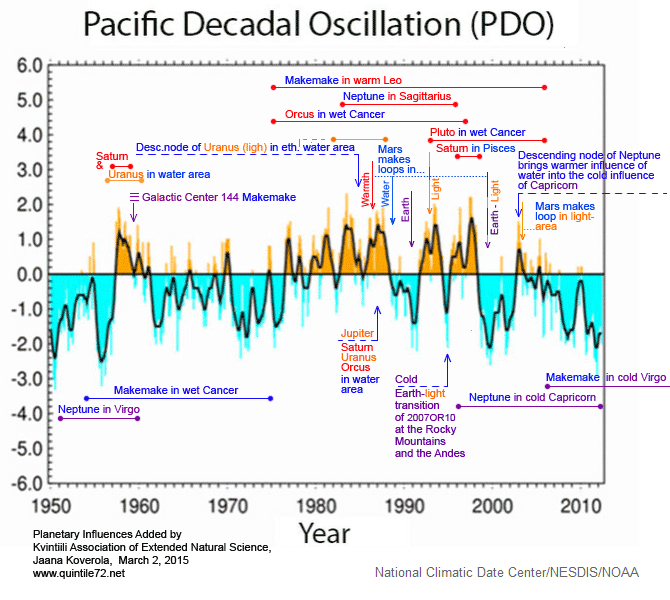
The planets and dwarf planets, which represent etheric element water, are Mars, Neptune, Makemake and also the Moon, and they have
particularly strong influence on the oceans. Thus their own quality steers them to work with those wet areas. But the long-lasting
etheric quality they are directing to the oceans is determined by the area in the Zodiac, where they are currently located as seen from the Earth.
Every star constellation shows the direction of specific influences from the Cosmos onto the Earth: warmth, light, water or coldness.
So we can consider the star constellations as traffic signs, which help us to find the directions of different etheric qualities.
(From the long-term influences mentioned above we have to separate the short term rainy influences of the
planetary constellations where these 'water planets' are participating.)
The other planets and dwarf planets representing THE OTHER elements, WHILE MOVING IN THE ETHERIC AREA OF ELEMENT WATER (in front of the
star constellations of Cancer, Scorpio or Pisces) radiate the etheric quality of THEIR OWN on the oceans.
Thus the etheric qualities of warmth and light are warming the oceans, element water keeps the temperature nearer the middle level and
the element earth makes the oceans cooler, especially together with the element light. The light intensifies both warmth and coldness
and the element water smooths both of them.
Mars stays in one etheric area usually for a month or two. During the longer periods when it is making its apparent loops (as seen from
the Earth), Mars may stay in one area even for eight months. In these cases its influence is clearly seen in the temperature curve.

“Since the end of last El Nino warming event of 1997 to 1998, the tropical Pacific Ocean has been in a relatively cool
phase — strong enough to offset the warming created by greenhouse gas emissions”, wrote Dr. Carolyn Gramling in the
Science News
.
The reason for the cool phase we can see in the pictures above and below. Particularly Neptune and Makemake moving in the cold etheric
areas seem to have been the main influence for the cooling.
Warming or cooling in following years?
Since 2011 Neptune has been located in the etheric light area
(continuing until 2020) and thus it has had a warming influence on the
oceans again since that time.
In the temperature measurements a clear warming has been noticed in 2014 and in the spring 2015 the warming was really notable. In the
element diagram made especially for the oceans, we see that from
February through April (as in the beginning of September) there has
been as many as seven warming etheric factors simultaneously at work in the oceans, where the faster-moving planets have a strong influence.
An El Niño event seems to be starting again.
In the pictures above and below we see that the temperature of the oceans is formed of several varying factors which often balance each
other. However the strongest influencer behind the PDO period of 20-30 years seems very clearly to be the dwarf planet Makemake. Its circuit
around the Sun takes 309 years and its influence on the oceans changes every 20-30 years when it moves from one etheric area to another
during its orbital journey.
The order of the etheric areas is always as follows: light, water, warmth, coldness, light, water etc.
Thus warmer and cooler periods fluctuate regularly.
The longest such period comes from the star constellation Virgo, which
represents coldness. For Makemake it takes 50 years to move through
that etheric area. The last time it travelled there was in 1700-1750
during the mini ice-age. Now it is in Virgo again.
How, then, will the temperature of the oceans form in the following years
and even decades? We can compare the progress of El Niño with the Element diagrams for the oceans (2017-2040).
In addition we should study carefully the etheric diagrams, which
are found in more detail here and for a longer time period here. Looking at them it is important to take into account the rules given above.
Some pondering maybe needed.
This new point of view may be strange for the majority of scientists.
However, there is no need to get startled by the star constellations or the Zodiac. Biodynamic farmers have worked with them for 90 years with
excellent results. They are familiar with the etheric forces and know how to utilize them best in growing of plants and taking care of
the soil and humus. Now we can take that same knowledge to a good use in the study of the weather and the climate.
|







